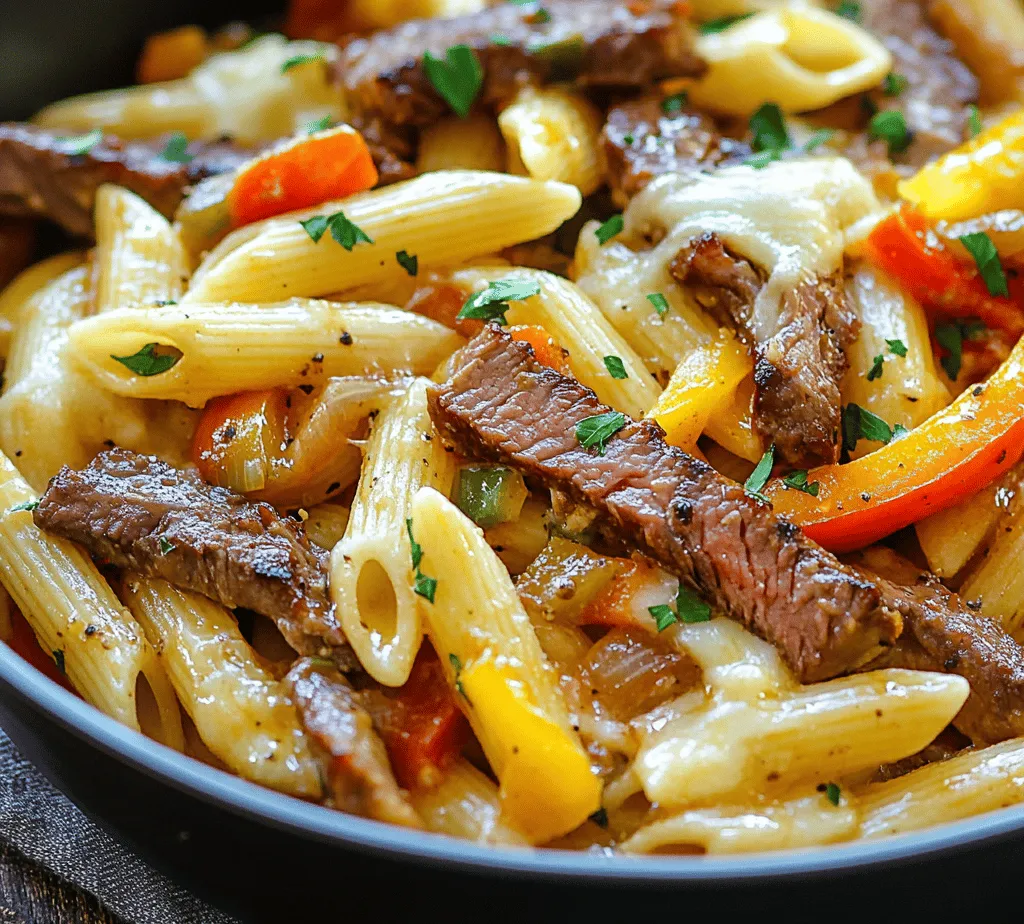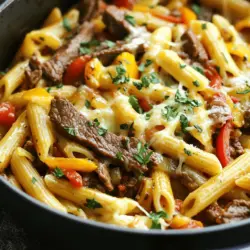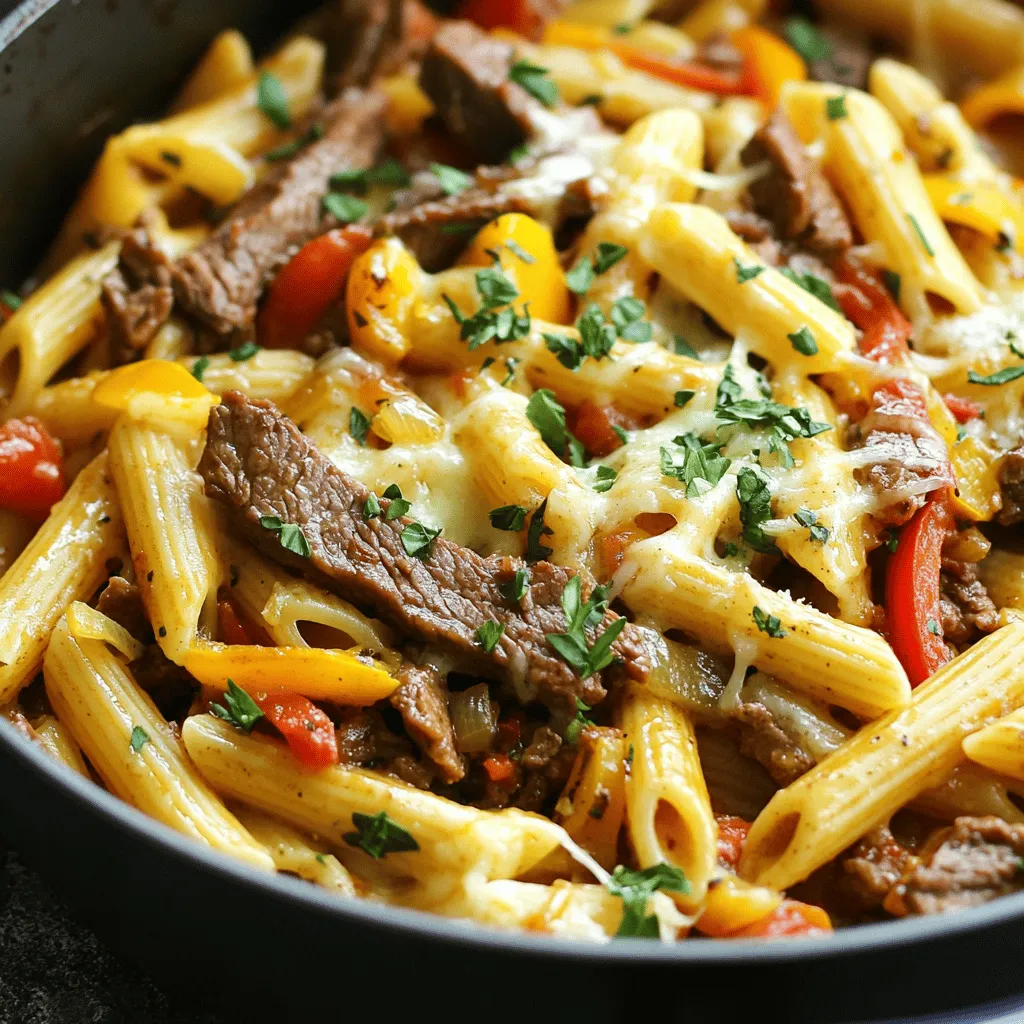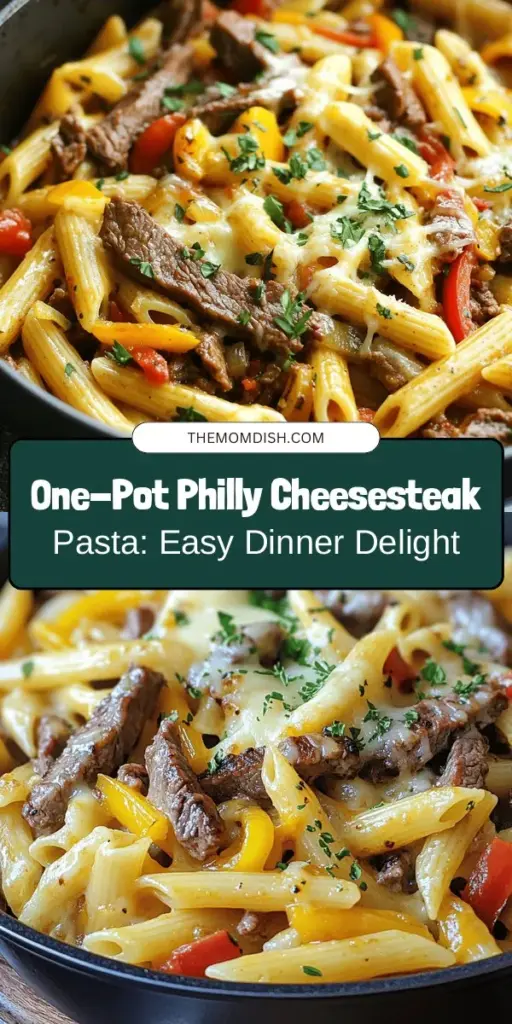Introduction
In the fast-paced world we live in, meal preparation can often feel overwhelming. This is where one-pot meals come to the rescue. Not only do they save time, but they also offer convenience without compromising on flavor. One-pot meals are a fantastic solution for busy weeknights or when you want to whip up something delicious without the hassle of multiple pots and pans. Today, we’re diving into a delightful recipe that embodies the best of both worlds: One-Pot Philly Cheesesteak Pasta.
This dish is a mouthwatering fusion of classic Philly cheesesteak flavors and hearty pasta, bringing together tender steak, sautéed vegetables, and a melty cheese sauce all in one pot. The result is a comforting meal that is rich, satisfying, and sure to please the whole family. With its savory profile and creamy texture, this recipe is bound to become a household favorite. Plus, it requires minimal cleanup, making it an easy choice for any home cook.
The Allure of One-Pot Cooking
Benefits of One-Pot Meals
The popularity of one-pot meals has surged in recent years, and for good reason. These meals are designed to streamline the cooking process by combining all the ingredients into a single pot, which not only simplifies cooking but also enhances the flavors. Here are some key benefits of this cooking method:
1. Ease of Preparation: One-pot meals require fewer steps in the cooking process. You can often prepare, cook, and serve from the same pot, making it an efficient and straightforward way to get dinner on the table.
2. Minimal Cleanup: Perhaps one of the most appealing aspects of one-pot cooking is the reduction in dishes to wash afterward. With everything cooked in a single vessel, you can enjoy your meal without the dread of a mountain of dishes waiting for you.
3. Flavor Melding: Cooking ingredients together allows flavors to intermingle, resulting in a more cohesive and aromatic dish. As everything simmers together, the broth absorbs the essence of the steak, vegetables, and spices, creating a layered taste experience that is hard to resist.
The combination of these factors makes one-pot meals a favorite among home cooks, especially those looking for quick, delicious solutions to their everyday dining dilemmas.
Ingredient Spotlight
Now that we understand the appeal of one-pot meals, let’s take a closer look at the star ingredients in our One-Pot Philly Cheesesteak Pasta. Each component plays a crucial role in creating a dish that is not only tasty but also well-balanced in flavor and nutrition.
Key Ingredients
– Penne Pasta: The choice of pasta is essential, and penne is an excellent option due to its tubular shape that holds sauce well. Its texture allows it to absorb the flavors of the broth while providing a satisfying bite. Additionally, penne cooks relatively quickly, making it ideal for a speedy dinner.
– Flank Steak: This cut of beef is known for its rich flavor and tenderness when cooked properly. Flank steak works beautifully in this recipe as it lends a hearty element to the dish. When seasoned and seared correctly, it contributes to the overall depth of flavor that is characteristic of a traditional Philly cheesesteak.
– Vegetables: Bell peppers and onions are the classic choices for a Philly cheesesteak, providing not only a burst of color but also essential nutrients. Bell peppers are rich in vitamins A and C, while onions offer antioxidants and flavor complexity. When sautéed, these vegetables sweeten and soften, enhancing the overall taste of the dish.
– Provolone Cheese: A hallmark of the Philly cheesesteak experience, provolone cheese adds creaminess and a distinctive flavor that ties the dish together. As it melts, it creates a luscious, cheesy coating that clings to the pasta and steak, elevating the entire meal.
Potential Ingredient Substitutions
One of the great things about cooking is the ability to customize recipes according to your dietary preferences or what you have on hand. Here are a few substitutions you can consider:
– Pasta Alternatives: If you prefer whole-grain options or gluten-free pasta, feel free to substitute penne with your choice of pasta. Just keep in mind that cooking times may vary.
– Protein Options: If flank steak isn’t available, you can use sirloin, ribeye, or even chicken breast for a lighter option. For a vegetarian version, consider using mushrooms or tofu as a meat substitute.
– Cheese Variations: While provolone is traditional, you can experiment with other cheeses such as mozzarella for a milder flavor or pepper jack for a spicy kick.
By making these simple adjustments, you can tailor the One-Pot Philly Cheesesteak Pasta to fit your taste and dietary needs while maintaining its delicious core.
Step-by-Step Preparation Guide
Now that we’ve gathered our ingredients and discussed their roles, let’s dive into the step-by-step preparation of this flavorful dish. This method ensures that each component is cooked to perfection and that the final result is nothing short of spectacular.
Preparing the Steak
1. Seasoning: Start by seasoning your flank steak generously with salt and pepper. This initial seasoning is crucial as it enhances the flavor of the meat. You can also add garlic powder or smoked paprika for an extra flavor boost.
2. Searing the Steak: Heat a large pot or Dutch oven over medium-high heat and add a drizzle of olive oil. Once the oil is shimmering, add the seasoned flank steak to the pot. Sear the steak for about 3-4 minutes on each side until it develops a nice brown crust. This step is essential for locking in the juices and building flavor.
3. Resting the Steak: After searing, remove the steak from the pot and let it rest on a cutting board for about 5 minutes. This resting period allows the juices to redistribute, ensuring that the meat remains tender when sliced.
Sautéing the Vegetables
1. Cooking the Aromatics: In the same pot used for the steak, add sliced onions and bell peppers. Sauté for about 5-7 minutes over medium heat until the vegetables are softened and translucent. Stir occasionally to prevent sticking and to ensure even cooking.
2. Building Flavor: As the vegetables cook, consider adding minced garlic and a pinch of red pepper flakes for a hint of heat. This step will infuse the oil with aromatic flavors that will enhance the overall dish.
3. Combining Ingredients: Once the vegetables are tender and fragrant, return the flank steak to the pot and slice it into thin strips. This will allow the steak to mix well with the vegetables, creating a harmonious blend of flavors.
With the steak and vegetables perfectly prepared, you’re well on your way to a delightful One-Pot Philly Cheesesteak Pasta that promises to be a hit at the dinner table. Stay tuned for the continuation of this recipe, where we’ll cover the next steps in cooking the pasta and creating that irresistible cheesy sauce that ties everything together.




